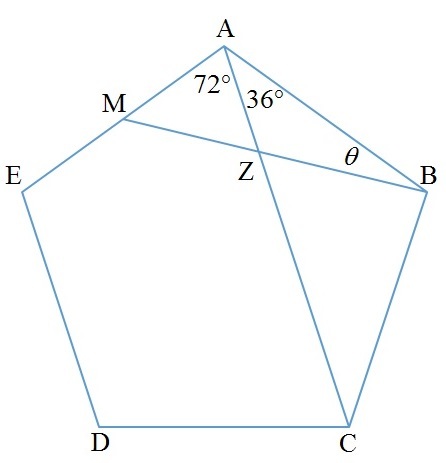Pentagon Problem
In regular pentagon A B C D E , point M is the midpoint of side A E .
If line segments A C and B M intersect at point Z and Z A = 3 , what is the length of A B ?
This section requires Javascript.
You are seeing this because something didn't load right. We suggest you, (a) try
refreshing the page, (b) enabling javascript if it is disabled on your browser and,
finally, (c)
loading the
non-javascript version of this page
. We're sorry about the hassle.
3 solutions
Very nice construction of P . What motivated that?
Log in to reply
I could see that AB and Ce were parallel and hence went to extend for similarity.

Let the side length of the regular pentagon A B C D E be a . By sine rule , we have:
A M sin ∠ A B M 2 a sin ∠ A B M 2 sin θ 2 sin θ 2 sin θ tan θ = A B sin ∠ A M B = a sin ( 1 8 0 ∘ − ∠ E A B − ∠ A B M ) = sin ( 1 8 0 ∘ − 1 0 8 ∘ − θ ) = sin ( 7 2 ∘ − θ ) = sin 7 2 ∘ cos θ − sin θ cos 7 2 ∘ = 2 + cos 7 2 ∘ sin 7 2 ∘ Let ∠ A B M = θ
By sine rule again,
A Z sin ∠ A B M 3 sin θ a sin θ a sin θ tan θ = A B sin ∠ A Z B = a sin ( 1 8 0 ∘ − 3 6 ∘ − θ ) = 3 sin ( 3 6 ∘ + θ ) = 3 sin 3 6 ∘ cos θ + 3 sin θ cos 3 6 ∘ = a − 3 cos 3 6 ∘ 3 sin 3 6 ∘
Therefore,
⟹ a − 3 cos 3 6 ∘ 3 sin 3 6 ∘ 3 sin 3 6 ∘ a − 3 cos 3 6 ∘ 3 a − 3 cos 3 6 ∘ ⟹ a = 2 + cos 7 2 ∘ sin 7 2 ∘ = sin 7 2 ∘ 2 + cos 7 2 ∘ = 2 cos 3 6 ∘ 2 + 2 cos 2 3 6 ∘ − 1 = 2 cos 3 6 ∘ 3 + 6 cos 2 3 6 ∘ + 3 cos 3 6 ∘ = 2 cos 3 6 ∘ 3 + 6 cos 3 6 ∘ See Note. = 2 ( 4 1 + 5 ) 3 + 6 ( 4 1 + 5 ) = 2 3 ( 1 + 5 4 + 1 + 5 ) = 3 5
Note: Using the identity below:
cos 5 π + cos 5 3 π 2 cos 5 π + 2 cos 5 3 π 2 cos 5 π − 2 cos 5 2 π 2 cos 5 π − 4 cos 2 5 π + 2 4 cos 2 5 π − 2 cos 5 π − 1 ⟹ cos 5 π = 2 1 = 1 = 1 = 1 = 0 = 4 1 + 5
Let [ X Y Z ] be the area of triangle △ X Y Z . We have ∠ Z A B = 3 6 ∘ , ∠ M A Z = 7 2 ∘ and [ A B M ] = [ A B Z ] + [ A Z M ] . Let A B = x , then: 2 x ⋅ 2 x sin 1 0 8 ∘ = 2 3 x sin 3 6 ∘ + 2 3 ⋅ 2 x sin 7 2 ∘ Solve for x , using the identity sin 1 0 8 ∘ = sin 7 2 ∘ : x = 3 ( sin 7 2 ∘ 2 sin 3 6 ∘ + sin 7 2 ∘ ) x = 3 ( 2 sin 3 6 ∘ cos 3 6 ∘ 2 sin 3 6 ∘ + 1 ) x = 3 ( cos 3 6 ∘ 1 + 1 ) x = 3 ( 5 − 1 + 1 ) x = 3 5
Claim: ∣ C E ∣ = φ × x .
Proof: We will apply Ptolemy's Theorem:
Inscribe a regular pentagon A B C D E inside a circle. WLOG, let its side length be 1 . If we let the length of the diagonal be x , then using Ptolemy's Theorem on ABCD tells us that x 2 = x + 1 . Using the quadratic formula and taking the positive root tells us that x = 2 1 + 5 = ϕ . Therefore, the length of the diagonal is ϕ multiplied by the side length.
Note that △ A M B ≅ △ E M P by A S A , hence ∣ E P ∣ = ∣ A B ∣ = x .
Now note that △ B Z A ∼ △ P Z C by A A A and ∣ A B ∣ = x while ∣ C P ∣ = ∣ C E ∣ + ∣ E P ∣ = ( 1 + φ ) ( x ) .
It follows that ∣ C Z ∣ = ( 1 + φ ) ∣ A Z ∣ = 3 + 3 φ . Hence ∣ A C ∣ = 6 + 3 φ and ∣ A B ∣ = φ ∣ A C ∣ = φ 6 + 3 φ = 3 5 .